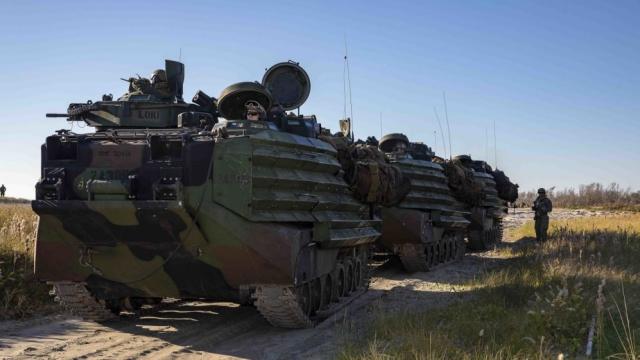When the robot uprising ends and the beaten remnants of humanity are put on trial, Exhibit A will be the day the Marines invented CRABS. CRABS, or Crawling Remotely-Operated Amphibious Breacher, will be autonomous robots designed to operate in the dangerous surf zone, under hostile fire, dismantling formidable beach defences with tools and, very likely, their own bodies.
CRABS will take over one of the most unsung, dangerous, and yet noble jobs in the entire U.S. Military, clearing the way for a seaborne invasion force to land and take the fight to the enemy.
During World War II the U.S. Navy created Underwater Demolition Teams, groups of frogmen that would go ashore in the early stages of a seaborne invasion and dismantle beach defences. Armed with explosives, these men would clear beaches by hand, under fire, with little or no cover, all the while roiled by surf. It’s no surprise that when the first Navy SEAL teams were formed, they drew heavily from UDT culture and actual personnel. In the run-up to the Allied the invasion of Peleliu:
Three days before D-Day, UDTs 6 and 7 deployed along the invasion beaches to destroy obstacles, but more critically, to blast wide ramps into the coral for the amphibious craft. Not only was their mission dangerous and in broad daylight, naval fire support from offshore flew overhead and periodic sniper and machine gun fire from shore targeted the unarmed swimmers in the shallow lagoon. The night before the assault, UDTs crawled ashore to demolish rock cribs, posts, barbed wire, concrete cubes, and set buoys off the reef to mark the newly blasted passageways.
Robots were always expected to do the military’s dangerous, dirty jobs. It’s only logical to send a robot in place of a person. Now, as Military.com reports, the Marines want the Crawling Remotely-Operated Amphibious Breacher to replace humans in the traditional UDT mission. According to the Marines:
The Crawling Remotely Operated Amphibious Breacher, or CRAB, will be a submersible, remote-autonomous system with front-end equipment—including a mine flail, tiller and rake—capable of breaching or proofing amphibious assault lanes for landing forces.
CRABS, the Marines explain, would be dumped into the ocean at a safe distance and then scuttle, underwater, towards enemy beachheads, to “remove explosive and nonexplosive obstacles from the assault lane.”
Armies of CRABS would converge on beachheads, then efficiently dismantle obstacles. It will probably surprise no one to learn that CRABS will be expendable, and it’s even possible that crabs might deliberately sacrifice themselves, destroying defences by scampering up to them and then detonating an explosive charge.
Rather than claws, the robotic crustaceans would be equipped with tools capable of digging out and destroying enemy beach defences. “(CRAB) will be a submersible, remote-autonomous system with front-end equipment—including a mine flail, tiller and rake—capable of breaching or proofing amphibious assault lanes for landing forces.”
The Marines already have the Assault Breacher Vehicle, an M1A1 tank chassis with a full-width mine plow and mine clearing rocket charges. The only problem is that the 60-ton ABV is not designed to work in the surf zone, and the low-slung vehicle would quickly become swamped with salt water if it tried.
All of this depends on whether or not there really is a future for amphibious warfare. Critics of America’s (expensive) amphibious forces point out that U.S. Marine Corps hasn’t conducted an amphibious assault since 1950, when it landed at Incheon. Supporters note there haven’t actually been any plausible opportunities for U.S. forces conduct a landing since the Korean War, but British, French, and Israeli forces have conducted landings as recently as 1982. In recent conflicts, the United States was fortunate to have local allies willing to host U.S. forces. In the future the U.S. may not be so lucky, and could require the Marines to carve out a foothold in hostile territory.
A prototype CRAB drone should be available by 2022, and the Marine Corps Systems Command submitted a proposal to the Office of Naval Research for use for the CRAB system as a Rapid Innovation Fund topic for fiscal 2020. Once approved, MCSC will begin a two-year process of developing a prototype.
But let’s imagine, for a second, that we’re in the far-off future of 2025, six years from now, when the only people left on Earth are our grandchildren’s grandchildren’s grandchildren. After a prolonged crisis, the United States and China are at war. A Chinese sentry guarding the People’s Liberation Army base on Woody Island in the South China Sea is conducting his nightly patrol, searching for signs of the Americans along his stretch of beach. He turns his flashlight and his attention to a cluster of Czech hedgehogs, spiky obstacles that recently were hastily anchored into the beach at the low tide line.
To his surprise, his flashlight beam catches several giant crablike machines, each the size of a small car, diligently dismantling the hedgehogs, while others rake the sand for mines. The CRABS pay him no mind.
The sentry calls for his superiors, who gather and watch the strange spectacle. Suddenly the roar of aircraft rotors fills the air, as an assault force of U.S. Marines in MV-22 Osprey tiltrotors heads for the island’s military airport. In the distance ahead, a Chinese officer with night vision goggles spies several assault amphibious vehicle, each laden with more than a dozen Marines, heading straight towards him. The invasion of Woody Island has begun, and the crablike machines paved the way.
CRABS will perform a valuable—and necessary—mission that will save human lives. Yet one can almost feel a tinge of guilt imagining CRABS, on order from a stern-faced Marine officer, lowering themselves en masse into the water from a warship, marching across the sea floor in toward their objective, and dutifully dismantling beach obstacles, all while taking horrendous casualties as enemy fire decimates their numbers. If so, just remember that humans did it first. And that shit rolls downhill.
